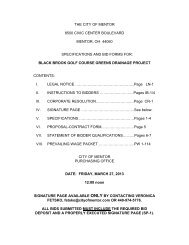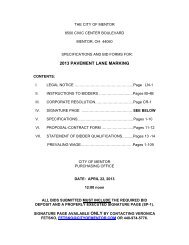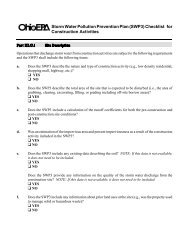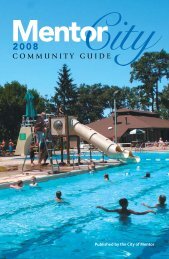Construction Site Inspection Checklist
Construction Site Inspection Checklist
Construction Site Inspection Checklist
You also want an ePaper? Increase the reach of your titles
YUMPU automatically turns print PDFs into web optimized ePapers that Google loves.
<strong>Construction</strong> <strong>Site</strong> <strong>Inspection</strong> <strong>Checklist</strong><br />
By making use of some simple Best Management Practices (BMPs) a construction site operator can do his or her share to<br />
protect Ohio's water resources from the harmful effects of sediment. The topography of the site and the extent of the<br />
construction activities will determine which of these practices are applicable to any given site, but the BMPs listed here<br />
are applicable to most construction sites. For details on the installation and maintenance of these BMPs, please refer to<br />
2006 Rainwater and Land Development, Ohio's Standards for Storm Water Management Land Development and Urban<br />
Stream Protection by the Ohio Department of Natural Resources (ODNR) Division of Soil and Water Conservation. The<br />
manual is available at http://www.dnr.state.oh.us/tabid/9186/Default.aspx or by contacting your county Soil and Water<br />
Conservation District.<br />
Temporary Stabilization<br />
This is the most effective BMP. All disturbed areas that will lie dormant for over 21 days must be stabilized within 7 days<br />
of the date the area becomes inactive. The goal of temporary stabilization is to provide cover, quickly. Areas within 50<br />
feet of a stream must be stabilized within 2 days of inactivity. This is accomplished by seeding with fast-growing grasses<br />
then covering with straw mulch. Apply only mulch between November 1 and March 31. To minimize your costs of<br />
temporary stabilization, leave natural cover in place for as long as possible. Only disturb areas you intend to work within<br />
the next 21 days.<br />
<strong>Construction</strong> Entrances<br />
<strong>Construction</strong> entrances are installed to minimize off-site tracking of sediments. A stone access drive should be installed<br />
at every point where vehicles enter or exit the site. Every individual lot should also have its own drive once construction<br />
on the lot begins.<br />
Sediment Ponds<br />
Sediment ponds are required for construction areas with concentrated runoff, when the design capacity of silt fence or<br />
inlet protection is exceeded, or for drainage areas with 10 or more disturbed areas. There are two types of sediment<br />
ponds: sediment basins and sediment traps. A sediment trap is appropriate where the contributing drainage area is 10<br />
acres or less. The outlet is an earthen embankment with a simple stone spillway. A sediment basin is appropriate for<br />
drainage areas larger than 10 acres. The outlet is an engineered riser pipe. Often a permanent storm water management<br />
pond, such as a retention or detention basin, can be modified to act as a sediment basin during construction. All sediment<br />
ponds must be installed within 7 days of first grubbing the area they control, provide a minimum dewatering zone of 67<br />
cubic yards per acre of total contributing drainage area and a sediment settling zone of 34 cubic yards per disturbed acre<br />
below the level of the outlet. Sediment basins must be designed to drain the dewatering zone over a 48-hour period.<br />
Silt Fence<br />
This is typically used at the perimeter of a disturbed area. It’s only for small drainage areas on relatively flat slopes or<br />
around small soil storage piles. Not suitable where runoff is concentrated in a ditch, pipe or through streams. For large<br />
drainage areas where flow is concentrated, collect runoff in diversion berms or channels and pass it through a sediment<br />
pond prior to discharging it from the site. Combination barriers constructed of silt fence supported by straw bales or silt<br />
fence embedded within rock check dams may be effective within small channels. As with all sediment controls, silt fence<br />
must be capable of pooling runoff so that sediment can settle out of suspension. Silt fence must be installed within 7 days<br />
of first grubbing the area it controls.<br />
Inlet Protection<br />
This must be installed on all yard drains and curb drains when these inlets do not drain to a sediment trap or basin. Even<br />
if there is a sediment trap or basin, inlet protection is still recommended, as it will increase the overall sediment removal<br />
efficiency. These are best used on roads with little or no traffic. If working properly, inlet protection will cause water to<br />
pond. If used on curb inlets, streets will flood temporarily during heavy storms. Check with your municipality before<br />
installing curb inlet protection. They may prefer an alternate means of sediment control such as silt fence or ponds.<br />
Permanent Stabilization<br />
All areas at final grade must be permanently stabilized within 7 days of reaching final grade. This is usually accomplished<br />
by using seed and mulch, but special measures are sometimes required. This is particularly true in drainage ditches or on<br />
steep slopes. These measures include the addition of topsoil, erosion control matting, rock rip-rap or retaining walls.<br />
Permanent seeding should be done March 1 to May 31 and August 1 to September 30. Dormant seeding can be done<br />
from November 20 to March 15. At all other times of the year, the area should be temporarily stabilized until a permanent<br />
seeding can be applied.<br />
Non-Sediment Pollution Control<br />
Although sediment is the pollutant of greatest concern on most construction sites, there are other sources of pollution.<br />
Most of these BMPs are easy to implement with a little bit of planning and go a long way toward keeping your site clean<br />
and organized. Please be sure to inform all contractors how these BMPs affect their operations on the site, particularly<br />
those that will be working near a stream.<br />
1<br />
May 2011
<strong>Inspection</strong> Sheet<br />
INSPECTIONS MUST BE CONDUCTED ONCE EVERY 7 DAYS AND WITHIN 24 HOURS OF A<br />
0.5" OR GREATER RAINFALL. ALL SEDIMENT CONTROLS MUST BE INSTALLED PRIOR TO<br />
GRADING AND WITHIN 7 DAYS OF FIRST GRUBBING<br />
GENERAL INSPECTION INFORMATION<br />
<strong>Construction</strong> <strong>Site</strong> <strong>Inspection</strong> Date: ______________ Inspector Name: ______________________________________<br />
Inspector Title: ______________________________ Qualifications/Certifications: _____________________________<br />
Storm Events of the Last 7 Days<br />
Storm Event Date Storm Event Time Storm Event Duration Total Rainfall Amount Discharge Occur? (Y/N)<br />
_______________ _______________ __________________ (inches) ___________________<br />
_______________ _______________ __________________ (inches) ___________________<br />
_______________ _______________ __________________ (inches) ___________________<br />
_______________ _______________ __________________ (inches) ___________________<br />
Weather Information at the Time of <strong>Inspection</strong><br />
Temperature _______ Climate (Sunny, Cloudy, Rain)? __________ Is Storm Water Being Discharged? __________<br />
Sketch or Small <strong>Site</strong> Map<br />
Along with a narrative inspection log, Ohio EPA recommends the inspector use a sketch or a reduced photocopy<br />
of the site plan showing the location of storm water outfalls and storm drain inlets as well as the location and<br />
types of control measures. Problems observed at these locations, or at other locations on the construction site,<br />
should be highlighted and any corrective measures undertaken should be drawn in and noted in detail on the<br />
front side of the sketch. This method will also be helpful as the permittee is required to update the SWP3 to<br />
reflect current site conditions.<br />
Key things to look for ...<br />
CONSTRUCTION ENTRANCES<br />
1. Has the drive been constructed by placing geotextile fabric under the stone?<br />
2. Is the stone 2-inch diameter?<br />
3. Has the stone been placed to a depth of 6 inches, with a width of 10 feet and a length of at least<br />
50 feet (30 feet for entrances onto individual sublots)?<br />
4. If the drive is placed on a slope, has a diversion berm been constructed across the drive to<br />
divert runoff away from the street or water resource?<br />
5. If drive is placed across a ditch, was a culvert pipe used to allow runoff to flow across the drive?<br />
Note areas where repairs or maintenance is needed or where this practice needs to be applied:<br />
2<br />
Yes No<br />
May 2011
Key things to look for ...<br />
SEDIMENT PONDS<br />
1. Are concentrated flows of runoff directed to a sediment pond?<br />
2. Is sheet-flow runoff from drainage areas that exceed the design capacity of silt fence (generally<br />
0.25 acre or larger) directed to a sediment pond?<br />
3. Is runoff being collected and directed to the sediment pond via the storm sewer system or via a<br />
network of diversion berms and channels?<br />
4. Is the sediment pond dewatering zone appropriately sized (67 cubic yards per acre of total<br />
drainage area)?<br />
5. Is the sediment pond sediment settling zone appropriately sized (34 cubic yards per acre of<br />
disturbed area)?<br />
6. Is the sediment basin riser outlet designed so that the dewatering zone will drain in no less time<br />
than 48 hours?<br />
7. Have the embankments of the sediment pond and the areas that lie downstream of the pond<br />
been stabilized?<br />
8. For sediment basins that dewater 100% between storms, is the riser pipe wrapped with chicken<br />
wire and double wrapped with geotextile fabric?<br />
9. Does the riser have 1-inch diameter holes spaced 4 inches apart, both horizontally and<br />
vertically?<br />
10. For sediment basins, which dewater 60% between storms, is the diameter of the dewatering<br />
hole per plan (see page 105 of Rainwater manual)?<br />
11. For sediment traps, is there geotextile under the stone spillway and is the spillway saddleshaped?<br />
12. For sediment traps, which dewater 100% between storms, is the dewatering pipe end-capped,<br />
no larger than 6 inches in diameter, perforated and double-wrapped in geotextile?<br />
13. Is the length-to-width ratio between inlet(s) and outlet at least 2:1? NOTE: If not, a baffle should<br />
be added to lengthen the distance.<br />
14. Is the depth from the bottom of the basin to the top of the primary spillway no more than 3 to 5<br />
feet?<br />
15. For a modified storm water pond being used as a sediment pond, is the connection between<br />
the riser pipe and the permanent outlet water-tight?<br />
16. Was the basin installed prior to grading the site?<br />
17. Is it time to clean-out the sediment pond to restore its original capacity? Generally, sediment<br />
should be removed once the pond is half-full. Stabilize the dredged sediments with seed and<br />
mulch.<br />
Note areas where repairs or maintenance is needed or where this practice needs to be applied:<br />
3<br />
Yes No<br />
May 2011
Key things to look for ...<br />
1. Is the fence at least 4" to 6" into the ground?<br />
SILT FENCE<br />
2. Is the trench backfilled to prevent runoff from cutting underneath the fence?<br />
3. Is the fence pulled tight so it won't sag when water builds up behind it?<br />
4. Are the ends brought upslope of the rest of the fence so as to prevent runoff from going around<br />
the ends?<br />
5. Is the fence placed on a level contour? If not, the fence will only act as a diversion.<br />
6. Have all the gaps and tears in the fence been eliminated.<br />
7. Is the fence controlling an appropriate drainage area? Refer to page 119 of Rainwater manual.<br />
RULE OF THUMB: Design capacity for 100 linear feet of silt fence is 0.5 acres for slopes < 2%,<br />
0.25 acres for slopes 2% to 20%, & 0.125 acres for slopes 20% or more. Generally, no more<br />
than 0.25 acres should lie behind 100 feet of fence at 2% to 10% slope, i.e., the distance<br />
between the fence and the top of the slope behind it should be no more than 125 feet. The<br />
allowable distance increases on flatter slopes and decreases for steeper slopes.<br />
Note areas where repairs or maintenance is needed or where this practice needs to be applied:<br />
Key things to look for ...<br />
1. Does water pond around the inlet when it rains?<br />
INLET PROTECTION<br />
2. Has the fabric been replaced when it develops tears or sags?<br />
3. For curb inlet protection, does the fabric cover the entire grate, including the curb window?<br />
4. For yard inlet protection, does the structure encircle the entire grate?<br />
5. Is the fabric properly entrenched or anchored so that water passes through it and not under it?<br />
6. For yard inlet protection, is the fabric properly supported to withstand the weight of water and<br />
prevent sagging? The fabric should be supported by a wood frame with cross braces, or straw<br />
bales.<br />
7. Is sediment that has accumulated around the inlet removed on a regular basis?<br />
Note areas where repairs or maintenance is needed or where this practice needs to be applied:<br />
4<br />
Yes No<br />
Yes No<br />
May 2011
Key things to look for ...<br />
TEMPORARY STABILIZATION<br />
1. Are there any areas of the site that are disturbed, but will likely lie dormant for over 21 days?<br />
2. Have all dormant, disturbed areas been temporarily stabilized in their entireties?<br />
3. Have disturbed areas outside the silt fence been seeded or mulched?<br />
4. Have soil stockpiles that will sit for over 21 days been stabilized?<br />
5. Has seed and mulch been applied at the proper rate? In general, seed is applied at 3 to 5 lbs<br />
per 1000 sq ft and straw mulch is applied at 2-3 bales per 1000 sq ft.<br />
6. Has seed or mulch blown away? If so, repair.<br />
Note areas where repairs or maintenance is needed or where this practice needs to be applied:<br />
Key things to look for ...<br />
1. Are any areas at final grade?<br />
PERMANENT STABILIZATION<br />
2. Has the soil been properly prepared to accept permanent seeding?<br />
3. Has seed and mulch been applied at the appropriate rate (see page 169 of the Rainwater<br />
manual)?<br />
4. If rainfall has been inadequate, are seeded areas being watered?<br />
5. For drainage ditches where flow velocity exceeds 3.5 ft/s from a 10-year, 24-hour storm has<br />
matting been applied to the ditch bottom?<br />
6. If the flow velocity exceeds 5.0 ft/s, has the ditch bottom been stabilized with rock rip-rap?<br />
NOTE: Rock check dams may be needed to slow the flow of runoff.<br />
7. Has rock rip-rap been placed under all storm water outfall pipes to prevent scouring in the<br />
receiving stream or erosion of the receiving channel?<br />
8. For sites with steep slopes or fill areas, is runoff from the top of the site conveyed to the bottom<br />
of the slope or fill area in a controlled manner so as not to cause erosion?<br />
Note areas where repairs or maintenance is needed or where this practice needs to be applied:<br />
5<br />
Yes No<br />
Yes No<br />
May 2011
Key things to look for ...<br />
NON-SEDIMENT POLLUTION CONTROL<br />
1. Has an area been designated for washing out concrete trucks? Washings must be contained on<br />
site within a bermed area until they harden. The washings should never be directed toward a<br />
watercourse, ditch or storm drain.<br />
2. Is waste and packaging disposed of in a dumpster? Do not burn them on site.<br />
3. Are fuel tanks and drums of toxic and hazardous materials stored within a diked area or trailer<br />
and away from any watercourse, ditch or storm drain?<br />
4. Are streets swept as often as necessary to keep them clean and free from sediment? NOTE:<br />
Sediment should be swept back onto the lot - not down the storm sewers.<br />
5. Are stockpiles of soil or other materials stored away from any watercourse, ditch or storm drain?<br />
6. Have stream crossings been constructed entirely of non-erodible material?<br />
7. If an area of the site is being dewatered, is it being pumped from a sump pit or is the discharge<br />
directed to a sediment pond? NOTE: if you must lower ground water, the water may be<br />
discharged to the receiving stream as long as the water remains clean. Be sure not to co-mingle<br />
the clean ground water with sediment-laden water or to discharge it off-site by passing it over<br />
disturbed ground.<br />
Note areas where repairs or maintenance is needed or where this practice needs to be applied:<br />
6<br />
Yes No<br />
May 2011
















